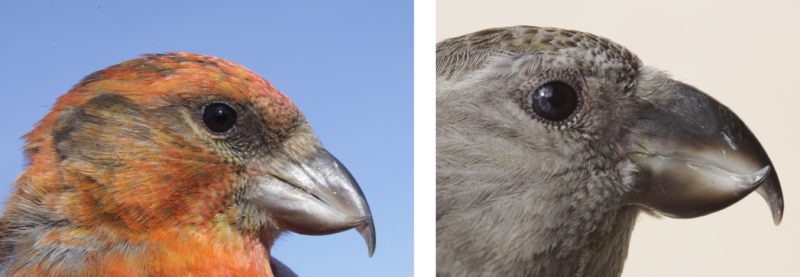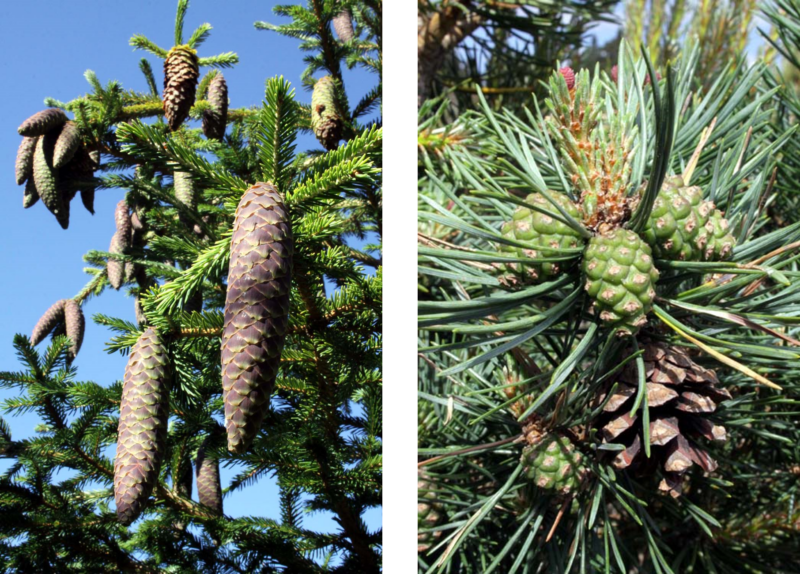LINKED PAPER
Irruptions of crossbills Loxia spp. in northern Europe – patterns and correlations with seed production by key and non-key conifers. Summers, R.W., Swallow, B.T., Fridman, J., Hokkanen, T. Newton, I., Buckland, S.T. 2024. IBIS. DOI: 10.1111/ibi.13328 VIEW
As with other boreal birds whose diet is limited to certain foods that vary in abundance from year to year, crossbills are renowned for carrying out irruptions from boreal forests to regions outside their usual range. The explanation for irruptions is linked to an imbalance between bird numbers and their food supply. In northwest Europe, the Common Crossbill’s main (key) food is the seeds of Norway Spruce whereas the key conifer for the Parrot Crossbill is the Scots Pine. The size difference between these species, especially with the bill, indicates how they are adapted to the different conifers (Photos 1 & 2). With its larger bill, the Parrot Crossbill is able to break into the tough woody cones of Scots Pine, whereas the smaller-billed Common Crossbill is more suited to foraging on the softer cones of Norway Spruce (Photos 3 & 4). So close are these associations that the Norwegian name for the Common Crossbill is the Grankorsnebb (translates as spruce crossbill) and the name for the Parrot Crossbill is the Furukorsnebb (pine crossbill).

Figure 1. A male Common Crossbill (left) and female Parrot Crossbill (right) , showing the size and shape difference in the bill. Parrot Crossbills are also larger in overall size © Ron Summers.
An interesting feature of the irruptions of the two species is that they often occur in the same year. This is unexpected because the cone cropping of the two conifers are not correlated, as shown from long-term data from Sweden and Finland. The lack of synchrony between the conifers may be due to the time between the development of the cone bud to the shedding of seed. The development and growth of Norway Spruce cones is spread over two calendar years whereas Scots Pine cones develop over three calendar years before seeding.
We investigated the pattern of irruptions of the two crossbills by comparing years of irruptions with indices of the size of cone (seed) crops in Sweden. An initial analysis, using data from 1911 to 2008, showed that irruptions into Britain and other parts of western Europe by both crossbill species were correlated with low seed production by Norway Spruce. Low seed production by Scots Pine also had a marginally non-significant additive effect on both crossbill species.

Figure 2. Norway Spruce cones (left) and Scots Pine cones (right) . The green Scots Pine cones are growing, whilst the brown one has shed its seeds © Ron Summers.
In a more sophisticated analysis, this time using counts of irrupting crossbills at Falsterbo in southern Sweden from 1973 to 2018, we found that the numbers of crossbills were correlated with a good crop by both conifers in the year prior to irruptions, plus low crops by both conifers in the year of an irruption. Our interpretation of these findings is that the two crossbill species must be making use of the non-key conifers in years when the crop of the key conifer is poor, and it is only when, by chance, the two conifers coincide in poor cropping that irruptions occur.
Image credits
Blog posts express the views of the individual author(s) and not those of the BOU.
If you want to write about your research in #theBOUblog, then please see here





